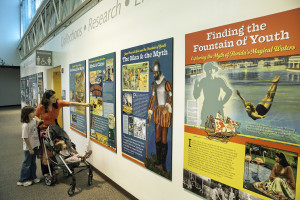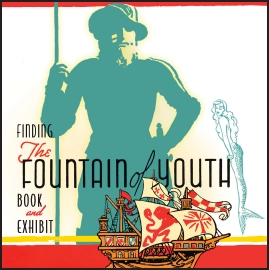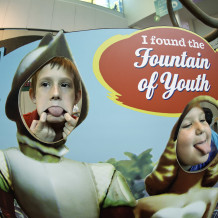Finding the Fountain of Youth: Exploring the Myth of Florida’s Magical Waters
Rick Kilby
Florida Museum of Natural History, March 23- December 15, 2013.
View a PDF of the exhibition panels here
Finding the Fountain of Youth: Exploring the Myth of Florida’s Magical Waters examines how the legend of Ponce de León’s quest for restorative waters shaped the Sunshine State’s image as a land of fantasy, rejuvenation, and magical spring-fed waters. Rich in images, this exhibition is based on the book by Rick Kilby, published by the University Press of Florida. It shows how the myths surrounding the discovery of “La Florida” influenced perceptions of the state that still echo today.

Rick Kilby’s Finding theFountain of Youth exhibition at the Florida Museum of Natural History, Gainesville, through Dec 15th 2013.
Much of Florida’s identity has been shaped by a connection to the idea that the state and its waters have restorative powers; this concept has been demonstrated in advertising and souvenirs in everything from the citrus industry to the business of tourism. The amusing vintage ads, colorful marketing pieces, and archival photographs in Finding the Fountain of Youth provide a cultural and historical context for Florida’s current struggles to protect its waters.
Juan Ponce de León reached the shores of Florida on April 2, 1513. Although the myth of the conquistador’s quest for the fountain of youth was debunked long ago, his fabled search remains inextricably tied to the image of the Sunshine State.
About the book:
Featuring reproductions of hundreds of eye-catching postcards, vintage advertisements, vibrant photos, and other “Ponceabilia,” Finding the Fountain Youth reveals how Florida itself has been transformed into a veritable fountain of youth, a paradisiacal playground, a utopia of rejuvenating springs and supple mermaids.
Kilby’s delightful collection of images demonstrates how “magical” waters and their restorative powers have been used to promote the state to tourists and new residents alike. Moving beyond advertising and kitsch, Kilby carries the story into the present day, addressing the very real problem of protecting Florida’s fragile springs and aquifers. Once revered by the Timucua and Calusa, then celebrated by writers such as William Bartram and Harriet Beecher Stowe, these pristine waters were rechristened Panacea Springs or Espiritu Santo Springs, new names meant to extol their sacred nature to visitors in polka-dotted bathing suits and Panama hats.
Florida, the mythical Land of Sunshine, encompasses over 700 freshwater springs–more than anywhere else in the world. Many of them, including Silver Springs, with its iconic glass-bottom boats, are now cloudy and endangered. Kilby reminds us that more than environmental damage is at stake; the search for the fountain(s) of youth defines who we are as Floridians.





